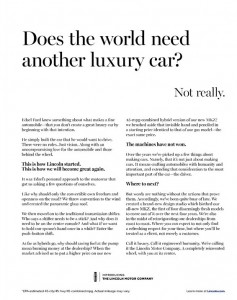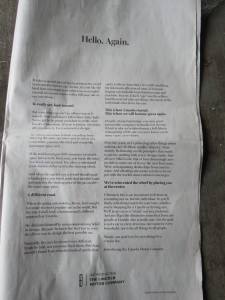While many brands made a political statement with ads on the 2017 Super Bowl, Cadillac saved theirs for the (surprisingly non-political) Academy Awards telecast. “We are a nation divided. That’s what they tell us, right?” the ad begins. “But what they don’t tell you, what doesn’t make the news, is this: We carry each other forward.” And we have a series of clips of Americans supporting or carrying others, sometimes literally.
Next we go to a montage of historical figures standing next to their Cadillacs. “No matter who we are, or what we believe, or where we come from, we’ve had the privilege to carry a century of humanity,” the ad continues. The “carry” metaphor is not very subtle, but it speaks well to Cadillac’s history as a symbol of having made it. I grew up in a suburb of Dallas with a very eclectic population mix—from college professors to poultry distributors, and from aristocrats with a long southern heritage to first generation immigrants.
Some folks thought owning a Cadillac was a way to show off your prosperity; my Uncle Jim bought a new one every year. But others would never own a Cadillac because it was not appropriate to be so ostentatious. I suspect the new Cadillac campaign is speaking to the first group. You may live in fear of deportation, you may belong to an ethnic group that is the subject of hate crimes, but if you have money for the down payment at least you can drive a nice car.
As it wraps things up, Cadillac stretches its metaphor a bit too far in my opinion. “But maybe what we carry isn’t just people. It’s an idea. That while we’re not the same, we can be one. And all it takes is the willingness to dare.” And we close with the Cadillac logo and the tag line, “Dare Greatly.” (The tag is not new, but was introduced with this campaign a couple of years ago.) Again, what we’re talking about is bourgeois prosperity. It’s the same kind of daring that might cause you to go for it with a nicer anniversary gift or a pricier steak than you had planned because, hey, this is America and you can. It’s really not that daring, but maybe it hits the Cadillac buyer’s sweet spot.
The branding continues to veer off course with the next spot, “Pioneers”. “We’ve always been dreamers. We’ve been a symbol of the future…. A standard… a star. But our past is just that, past. What lies ahead is in our hands.” And the ad goes on to introduce concept vehicles including self-driving and electric Cadillacs. The drivers in these vehicles are younger, much younger.
The third ad, “Pedestal”, starts with a vehicle literally on a pedestal surrounded by gawkers. A well-dressed 30ish woman comes forward, mesmerized. “We know how it feels to be treated like a trophy. Driven to awards shows… parties… and across so many silver screens…. But a Cadillac is no trophy, no museum piece. This is our future, and it will inspire every car that follows…. Intermission’s over. This is how we drive the world forward.” And now the mesmerized woman is behind the wheel while multiethnic pedestrians gawk at her good fortune.
The problem here is that Cadillac is trying to transform its brand and appeal to a new audience, yet its history is the reason for its cred. They should have done what Lincoln and Chrysler did, in high concept campaigns of the past. Tell your story, then shut up. The campaign can continue with product-focused features and performance ads, and buyers will connect the dots.
I’ll close with Electro Cadillac, presumably a current owner, who says much the same thing in a comment under the YouTube “Pioneers” video:
“I can’t believe this… This commercial is basically telling you that all the achievements and great cars that were made in the past, history (which, let’s be honest is much better than the weak plastic bullshit we have today) let’s just throw all that in the garbage… I enjoy driving and all this ‘futuristic’ crap is getting on my nerves with every single day going by…
“One thing that is fundamental guys, Cadillac hear me out: You can’t beat the old school. Those flimsy plastic bumpers will never compare to those good old chrome steel ones.
“And here is another thing. I am watching the Oscars as we speak, and your Escala commercial says this: ‘Our cars will never be like before’. Well that means that you’re not going to be Cadillac anymore.
“Here is a new slogan for you: There is no future without the past.”

